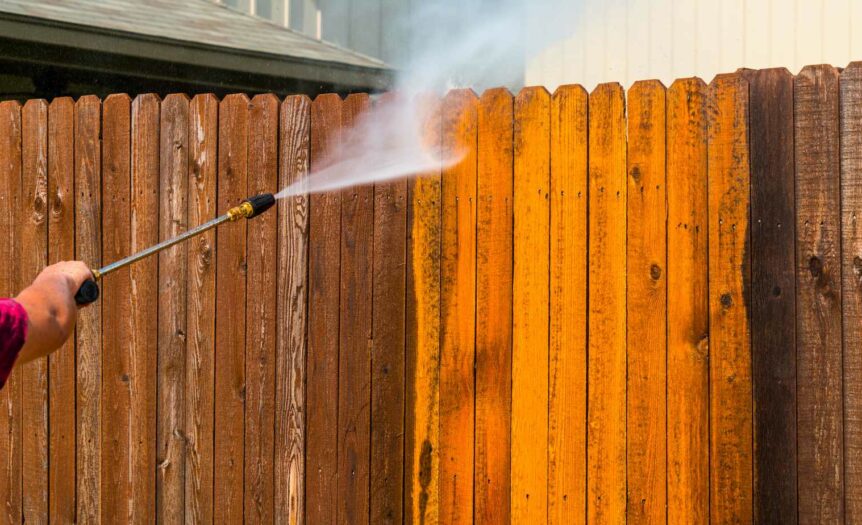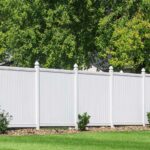Are you planning to revamp your fence and wondering how much stain you’ll need for the project? Staining your fence not only enhances its appearance but also prolongs its life by providing protection against the elements.
However, calculating the right amount of stain can be a bit tricky, considering factors like fence size, material, type of stain, and required coats. Worry not! Today, we will walk you through everything you need to know about estimating the amount of stain needed for your fencing project.
Factors To Consider When Calculating Stain Needs For A Fence
When calculating stain needs for a fence, factors such as the size and material of the fence, type of stain and coverage rates, and number of coats needed should be taken into consideration.
Fence Size And Material
One of the most crucial factors to consider when calculating the amount of stain needed for your fence is its size and material. The length, height, and surface area of your fence will determine how much stain you’ll need to cover it completely.
In addition to size, the type of wood used for your fence also plays a significant role in determining stain requirements. Different woods have varying absorbency rates; for example, cedar fences may require less stain compared to pressure-treated pine because they typically have lower absorption levels due to their natural oils.
Type Of Stain And Coverage Rates
There are many different types of stain available for your fence, each with varying coverage rates. It is important to choose the right type of stain for the wood and climate in your area.
Solid color stains provide excellent coverage, but some people prefer semi-transparent stains that allow natural wood grain to show through.
Coverage rates will vary depending on the type of stain you choose and factors such as surface roughness and the wood’s age. Generally speaking, solid color stains require less product per square foot than semi-transparent or clear finishes because they have a higher concentration of pigment.
Number Of Coats Needed
Determining the number of coats needed for your fence staining project is crucial to ensure you purchase enough stain and achieve a satisfactory finish. Typically, two coats are recommended for most fences, although certain factors may require additional coats.
For instance, if your fence has aged or weathered wood, it may need an extra coat to achieve a uniform look.
It’s important to note that applying multiple coats does not always yield better results; using too much stain can lead to blotching and uneven coloring on the fence surface.
How To Calculate The Amount Of Stain Needed For A Fence
To calculate the amount of stain needed for a fence, measure the fence’s dimensions, determine the coverage rate of the chosen stain, and adjust for knots or surface roughness before dividing total square footage by coverage per gallon.
Measuring The Fence
To accurately estimate the amount of stain required for your fence, you need to measure it properly. Start by measuring the length and height of each section of the fence, then multiply those numbers together to get your square footage.
If there are any gates or irregular sections, be sure to measure those separately as well.
Once you have your total square footage, use a fence paint or stain calculator to determine how much product you’ll need based on the coverage rate per gallon. Keep in mind that the coverage may vary depending on factors such as the type of wood and whether it’s aged or rough.
Determining The Coverage Rate Of The Stain
The coverage rate of the stain is an essential factor to consider when calculating how much stain you need for your fence. The coverage rate refers to the area that a single gallon of stain can cover in square feet.
This may vary depending on several factors such as the type and brand of stain, the condition and age of your fence, and the number of coats required.
To determine the coverage rate per gallon, consult with the manufacturer’s recommendations or check it on their website. In general, most manufacturers specify that one gallon covers around 150-200 sq.ft., but this varies based on surface porosity and other factors mentioned above.
Using these tips will help you purchase efficient amounts of staint as well as ensuring that you’re not purchasing extra gallons unnecessarily”.
Adjusting For Knots And Surface Roughness
Knots and surface roughness can impact the amount of stain needed for a fence project. Rough or aged wood may require more stain compared to newer, smoother wood. In addition, knots on the wood may absorb more stain than surrounding areas, leading to uneven coverage if not accounted for properly.
To adjust for knots and rough surfaces, it is recommended to apply additional coats of stain in those areas using a brush or roller. It’s important to note that applying too much stain in one area may lead to drips or runs, which can create an unsightly finish.
Tips For Buying And Applying Stain To A Fence
When buying and applying stain to a fence, it is important to choose the right type of stain for your specific wood and climate, properly prepare the fence surface by cleaning and sanding if necessary, use the appropriate tools for application such as brushes or sprayers, and consider professional installation for larger projects.
Choosing The Right Type Of Stain
Choosing the right type of stain for your fence is crucial to achieving a long-lasting and beautiful finish. There are two main types of stains: solid color stains and semi-transparent stains.
Solid-color stains provide excellent coverage by completely covering up the natural wood grain, while semi-transparent stains allow some of the wood’s natural beauty to show through with a transparent or tinted finish.
It is important to consider factors such as durability, longevity, and maintenance when selecting a stain type that best suits your needs.
Properly Preparing The Fence Surface
Before applying stain to your fence, it is crucial to properly prepare the surface. First, remove any dirt, debris, or loose paint using a wire brush and power washer.
Next, ensure that the fence is completely dry before applying stain. Moisture on the surface may prevent proper adhesion of the stain and lead to an uneven finish.
If there are knots in the wood or other rough areas on the fence’s surface, use a wood conditioner prior to staining.
In addition, always check product labels for specific instructions related to preparation and application of stains.
Using The Right Tools For Application
Choosing the right tools for staining your fence is just as important as selecting the right type of stain. Using low-quality brushes or rollers could result in uneven coverage and a less than desirable finished product.
A quality brush or sprayer with long bristles works best when it comes to applying stain to a fence. If using a brush, make sure it’s designed for water-based stains and is at least two inches wide to ensure you can cover large areas quickly.
Investing in high-quality tools may seem like an unnecessary expense, but it will pay off in the long run by providing better results that last longer.
Considering Professional Installation For Large Projects
Staining a fence can be a challenging and time-consuming undertaking, especially for larger projects. That’s why it may be worth considering hiring a professional contractor to handle the job.
For example, if you have an expansive wood fence surrounding your property, hiring a professional could save you significant amounts of time and money. Not only will they provide expert advice on which type of stain to use but they can also take care of all preparation work such as sanding or pressure washing before applying the stain.
Additionally, by hiring a pro, you’ll avoid accidental damage to your fence or other parts of your home during the staining process.
Importance Of Properly Staining Your Fence And Additional Tips
Properly staining your fence can help protect it from weathering, rotting, and insect damage, extending its lifespan significantly.
Average Cost Of Stain Per Gallon
When it comes to staining your fence, the cost of stain per gallon can vary based on various factors. The type of stain you choose, whether it’s a solid color or semi-transparent, and the brand of stain can all impact the price.
On average, you can expect to spend around $30-$40 per gallon of fence stain.
It’s essential to factor in the cost of materials when calculating how much staining your fence will cost overall. Additionally, labor costs associated with staining your fence should be taken into account as well.
Many contractors charge anywhere from $0.45-$0.80 per square foot for staining a fence, so make sure to get estimates from multiple professionals before making a final decision.
Labor Costs Associated With Staining A Fence
Hiring a contractor to stain your fence can be a wise choice, especially if you lack the necessary tools and equipment or have limited experience with DIY projects. Labor costs for staining a fence vary depending on various factors such as location, level of expertise, and the size of your project.
Most contractors charge between $0.45 to $0.80 per square foot to stain a fence, meaning that an average 1,800 square foot wood fence can cost around $810 in labor only costs for transparent (1 coat) stain application.
Benefits Of Staining Your Fence
Staining your fence provides a layer of protection that helps prevent rot, decay, and insect damage to the wood. This protective coating also helps to shield the fence from harsh sunlight, which can cause fading and discoloration over time.
Additionally, staining your fence enhances its natural beauty by bringing out the unique colors and characteristics of the wood grain. Regularly stained fences not only last longer but also maintain their aesthetic appeal for many years.
Maintaining Your Fence After Staining
After you have successfully stained your fence, it is crucial to maintain it properly for a prolonged lifespan. One of the best ways to maintain your newly-stained fence is by regularly cleaning and inspecting it.
Clean the fence with soap and water or a power washer to prevent dirt buildup, mold, and mildew growth.
Additionally, keep an eye on the weather conditions in your area as extreme temperatures or sudden weather changes can damage your fence over time. It’s important to reapply stain every few years as recommended by manufacturers to ensure that the wood remains protected from harsh elements like UV rays and moisture.
Conclusion
Staining your fence is an important part of keeping it looking great and protecting it from the elements. By considering factors such as fence size, material, and coverage rates when calculating stain needs, you can accurately estimate the amount of stain needed for your project.
Using a fence paint or stain calculator can also help make this process easier. When selecting a type of stain, be sure to choose one that suits your needs and budget. Properly preparing the surface before staining and using the right tools for application can also help ensure great results.






